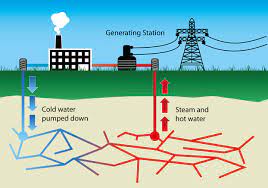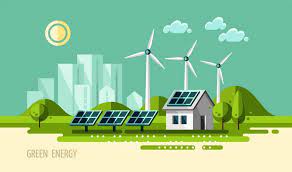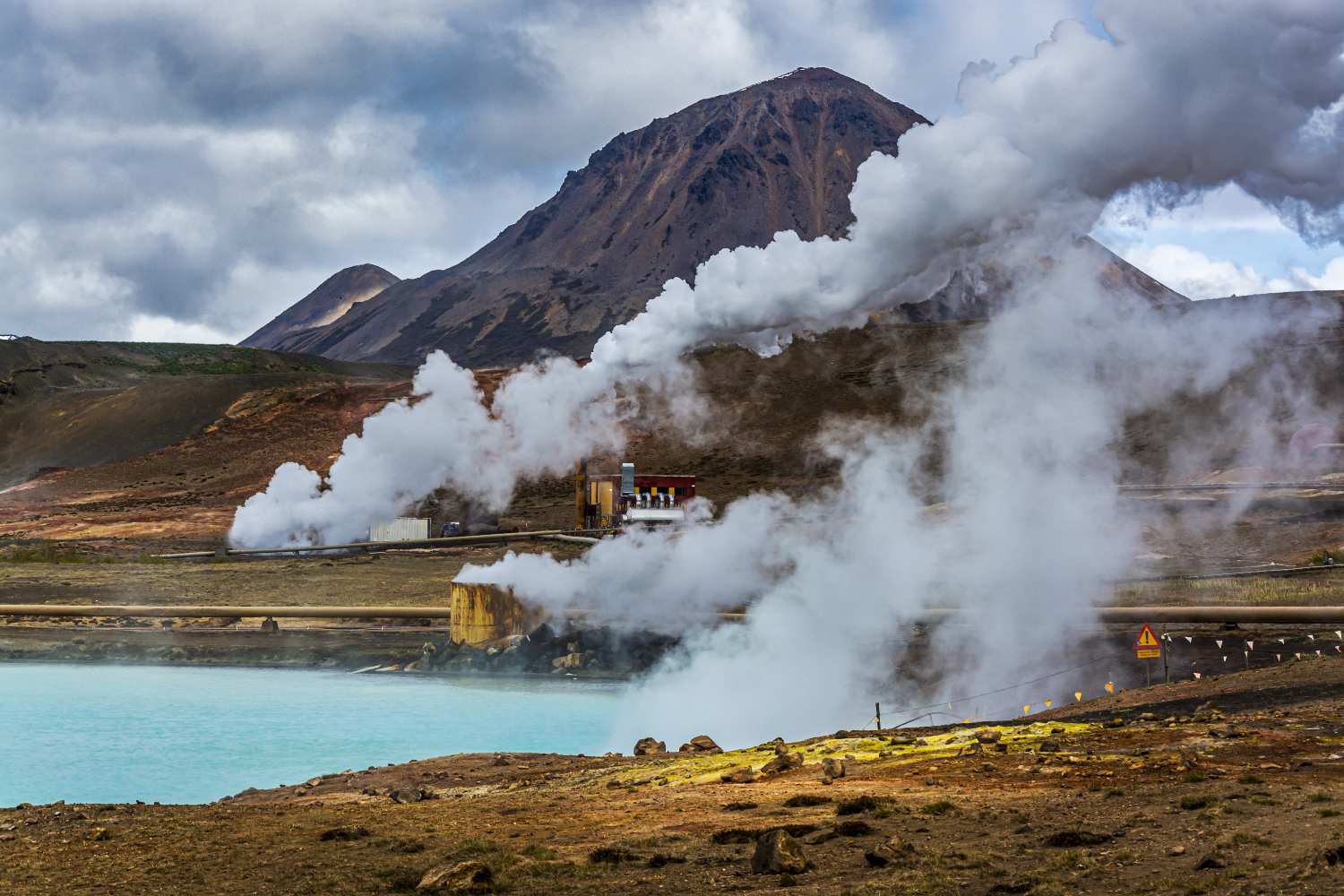Geothermal and wind energy
Courtesy : en.wikipedia.org/
Geothermal energy is the thermal energy in the Earth’s crust which originates from the formation of the planet and from radioactive decay of materials in currently uncertain[1] but possibly roughly equal[2] proportions. The high temperature and pressure in Earth’s interior cause some rock to melt and solid mantle to behave plastically. This results in parts of the mantle convecting upward since it is lighter than the surrounding rock. Temperatures at the core–mantle boundary can reach over 4000 °C (7200 °F).[3]
Geothermal heating, using water from hot springs, for example, has been used for bathing since Paleolithic times and for space heating since ancient Roman times. More recently geothermal power, the term used for generation of electricity from geothermal energy, has gained in importance. It is estimated that the earth’s geothermal resources are theoretically more than adequate to supply humanity’s energy needs, although only a very small fraction is currently being profitably exploited, often in areas near tectonic plate boundaries.
As a result of government assisted research and industry experience, the cost of generating geothermal power decreased by 25% over the 1980s and 1990s. More recent technological advances have dramatically reduced costs and thereby expanded the range and size of viable resources. In 2021, the U.S. Department of Energy estimates that geothermal energy from a power plant “built today” costs about $0.05/kWh.
In 2019, 13,900 megawatts (MW) of geothermal power was available worldwide.An additional 28 gigawatts of direct geothermal heating capacity has been installed for district heating, space heating, spas, industrial processes, desalination and agricultural applications as of 2010.
Forecasts for the future of geothermal power depend on assumptions about technology, energy prices, subsidies, plate boundary movement and interest rates. Pilot programs like EWEB’s customer opt in Green Power Program show that customers would be willing to pay a little more for a renewable energy source like geothermal. About 100 thousand people are employed in the industry.The adjective geothermal originates from the Greek roots γῆ (gê), meaning Earth, and θερμός (thermós), meaning hot.
History
The oldest known pool fed by a hot spring, built in the Qin dynasty in the 3rd century BCE
Hot springs have been used for bathing at least since Paleolithic times. The oldest known spa is a site where the Huaqing Chi palace was later built. In the first century CE, Romans conquered Aquae Sulis, now Bath, Somerset, England, and used the hot springs there to feed public baths and underfloor heating. The admission fees for these baths probably represent the first commercial use of geothermal power. The world’s oldest geothermal district heating system in Chaudes-Aigues, France, has been operating since the 15th century. The earliest industrial exploitation began in 1827 with the use of geyser steam to extract boric acid from volcanic mud in Larderello, Italy.
In 1892, America’s first district heating system in Boise, Idaho was powered directly by geothermal energy, and was copied in Klamath Falls, Oregon in 1900. The first known building in the world to utilize geothermal energy as its primary heat source was the Hot Lake Hotel in Union County, Oregon, whose construction was completed in 1907.A deep geothermal well was used to heat greenhouses in Boise in 1926, and geysers were used to heat greenhouses in Iceland and Tuscany at about the same time.Charlie Lieb developed the first downhole heat exchanger in 1930 to heat his house. Steam and hot water from geysers began heating homes in Iceland starting in 1943.
Global geothermal electric capacity. Upper red line is installed capacity;lower green line is realized production.
In the 20th century, demand for electricity led to the consideration of geothermal power as a generating source. Prince Piero Ginori Conti tested the first geothermal power generator on 4 July 1904, at the same Larderello dry steam field where geothermal acid extraction began. It successfully lit four light bulbs.Later, in 1911, the world’s first commercial geothermal power plant was built there. It was the world’s only industrial producer of geothermal electricity until New Zealand built a plant in 1958. In 2012, it produced some 594 megawatts.
In 1960, Pacific Gas and Electric began operation of the first successful geothermal electric power plant in the United States at The Geysers in California.The original turbine lasted for more than 30 years and produced 11 MW net power.
The binary cycle power plant was first demonstrated in 1967 in the USSR and later introduced to the US in 1981. This technology allows the generation of electricity from much lower temperature resources than previously. In 2006, a binary cycle plant in Chena Hot Springs, Alaska, came on-line, producing electricity from a record low fluid temperature of 57 °C (135 °F).
In 2021 Quaise Energy announced the idea of using a gyrotron as a boring machine to drill a hole 20 kilometers in depth and use it to produce geothermal energy. The technique would use frequencies of 30 to 300 GHz and would transfer energy to a rock 1012 (1 trillion) times more efficiently than using a laser. Lasers would further be disrupted by the vaporized rock, which would effect the longer-wavelength much less. Drilling rates of 70 meters/hour appear to be possible with a 1-MW gyrotron that can achieve 100 percent efficiency.
Resources
Enhanced geothermal system 1:Reservoir 2:Pump house 3:Heat exchanger 4:Turbine hall 5:Production well 6:Injection well 7:Hot water to district heating 8:Porous sediments 9:Observation well 10:Crystalline bedrock
The Earth’s internal thermal energy flows to the surface by conduction at a rate of 44.2 terawatts (TW),[20] and is replenished by radioactive decay of minerals at a rate of 30 TW.[21] These power rates are more than double humanity’s current energy consumption from all primary sources, but most of this energy flow is not recoverable. In addition to the internal heat flows, the top layer of the surface to a depth of 10 m (33 ft) is heated by solar energy during the summer, and releases that energy and cools during the winter.
Outside of the seasonal variations, the geothermal gradient of temperatures through the crust is 25–30 °C (45–54 °F) per km of depth in most of the world. The conductive heat flux averages 0.1 MW/km2. These values are much higher near tectonic plate boundaries where the crust is thinner. They may be further augmented by fluid circulation, either through magma conduits, hot springs, hydrothermal circulation or a combination of these.
The thermal efficiency and profitability of electricity generation is particularly sensitive to temperature. The most demanding applications receive the greatest benefit from a high natural heat flux, ideally from using a hot spring. The next best option is to drill a well into a hot aquifer. If no adequate aquifer is available, an artificial one may be built by injecting water to hydraulically fracture the bedrock. This last approach is called hot dry rock geothermal energy in Europe, or enhanced geothermal systems in North America. Much greater potential may be available from this approach than from conventional tapping of natural aquifers.
Estimates of the potential for electricity generation from geothermal energy vary sixfold, from 0.035to2TW depending on the scale of investments.Upper estimates of geothermal resources assume enhanced geothermal wells as deep as 10 kilometres (6 mi), whereas existing geothermal wells are rarely more than 3 kilometres (2 mi) deep. Wells of this depth are now common in the petroleum industry.The deepest research well in the world, the Kola superdeep borehole, is 12 kilometres (7 mi) deep.
Geothermal power
Main article: Geothermal power
Installed geothermal energy capacity, 2019
Geothermal power is electrical power generated from geothermal energy. Technologies in use include dry steam power stations, flash steam power stations and binary cycle power stations. Geothermal electricity generation is currently used in 26 countries,while geothermal heating is in use in 70 countries.
As of 2019, worldwide geothermal power capacity amounts to 15.4 gigawatts (GW), of which 23.86 percent or 3.68 GW are installed in the United States.International markets grew at an average annual rate of 5 percent over the three years to 2015, and global geothermal power capacity is expected to reach 14.5–17.6 GW by 2020.Based on current geologic knowledge and technology the GEA publicly discloses, the Geothermal Energy Association (GEA) estimates that only 6.9 percent of total global potential has been tapped so far, while the IPCC reported geothermal power potential to be in the range of 35 GW to 2 TW. Geothermal energy is a key renewable source that covers a significant share of the electricity demand in countries like Iceland, El Salvador, Kenya, the Philippines and New Zealand, and more than 90 % of the heating demand in Iceland.
Geothermal power is considered to be a sustainable, renewable source of energy because the heat extraction is small compared with the Earth’s heat content. The greenhouse gas emissions of geothermal electric stations are on average 45 grams of carbon dioxide per kilowatt-hour of electricity, or less than 5 percent of that of conventional coal-fired plants.
As a source of renewable energy for both power and heating, geothermal has the potential to meet 3-5% of global demand by 2050. With economic incentives, it is estimated that by 2100 it will be possible to meet 10% of global demand.





